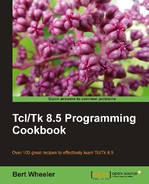The if command evaluates a condition and if the condition evaluates to true, the actions are performed. The condition must be Boolean. With the addition of the else and elseif keywords, multiple conditions may be evaluated and numerous actions can be performed.
In the following recipe, we will create a Tcl script to be called from the command line that evaluates the argument passed, and based on the argument provided, perform an action.
Create a text file named if.tcl that contains the following commands:
# Set the variable x to the argument
set x [lindex $argv 0]
# Test for condition 1
if {$x == 1} {
puts "Condition 1 - You entered: $x"
# Test for condition 1
} elseif {$x == 2} {
puts "Condition 2 - You entered: $x"
# If neither condition is met perform the default action
} else {
puts "$x is not a valid argument"
}
Now invoke the script using the following command line:
tclsh85 if.tcl 1
Condition 1 - You entered: 1
The if command has evaluated the argument passed; based on the argument value passed, it has evaluated the argument. As condition 1 was met, the first action was performed.
Now invoke using the following command line:
tclsh85 if.tcl 2
You entered: 2
As condition 2 was met, the second action was performed.
Now invoke using the following command line:
tclsh85 if.tcl x
x is not a valid argument
The if construct also provides the then keyword. When using multiple conditions, the then keyword can optionally be used for clarity, as you can see in the following example:
if {
$x in {1 2 3}
} then {
puts "$x"
}
Try rewriting the if.tcl script using multiple conditional statements.
